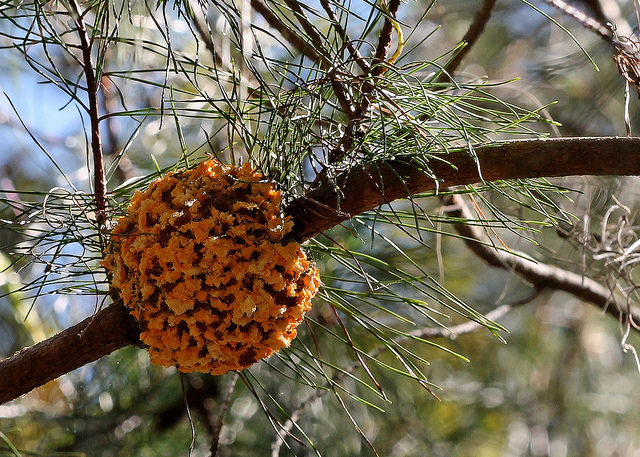Introduction
Pine-oak gall rust, also referred to as eastern gall rust, is a fungal disease that affects various pine and oak trees. The disease is native to North America. It is caused by the fungus, Cronartium quercum. The disease produces oblong to rounded galls on the stems or branches of infected trees. The galls increase in size each year, growing up to several inches in diameter. Fruiting structures develop on the galls, and rupture, covering the bark surface with a mass of powdery, orange-yellow spores. These spores are dispersed by air currents or splashes of rain to susceptible oaks, where they initiate new infections. Large galls can stunt plant growth, resulting in significant foliar dieback. Infections of the main stem often result in tree mortality.
Distribution & Habitat
Pine-oak gall rust occurs on susceptible pine and oak trees throughout the United States. It is most prevalent in the Southern and Western United States.
Hosts
Pine-oak gall rust infects a variety of pines. Scots, Austrian, ponderosa, Jack, mugo, red, and Virginia pine are the most commonly infected. Alternate hosts include northern pin, bur, pin, and northern red oak. Red and black oaks are especially prone to infection.
Disease Cycle
Pine-oak gall rust has a complex disease cycle that requires two hosts to achieve completion: a pine, and an oak. In spring or early summer, spores are released from fruiting structures on infected oak leaves. These spores are disseminated by the wind or rain to the needles and shoots of pine trees. The fungus invades susceptible pines through the needle stomata, or through wounds in the bark. The fungus germinates in the needles, or bark for up to forty eight hours. Once it has become established in the host, the fungus moves from the needles, or bark, into the vascular cambium of the branches, or stem. The presence of the fungus in the vascular cambium stimulates an increase of cell size, resulting in the formation of a gall. The galls continue to grow until the following spring, when they reach maturity. Throughout the growing season, the galls become enlarged. This produces a girdling effect, which inhibits the flow of water and nutrients to the infected branch, or stem. Infected branches often become brittle, rendering them prone to ripping, or snapping during snow or ice storms. Once mature, the bark on the galls cracks, and sloughs off, releasing an abundance of bright yellow-orange powdery spores. The spores are dispersed by air currents or splashes of rain to the leaves of nearby oak trees, which they readily infect.
During summer, clumps of powdery orange spores develop on the underside of infected oak leaves. The spores are released when conditions are sufficiently moist. However, they are only capable of infecting additional oak leaves. In late summer, dark brown to black hair-like structures appear on the lower leaf surface of infected oak leaves. These spore-producing structures, called telia, contain a specialized spore type that is capable of infecting pines. These spores are released in spring of the following year, once conditions are favorable. They are carried by the wind or rain to nearby pines, where they initiate new infections.
Symptoms of Infection
Small galls may be visible after the first year of infection. The galls appear as round to oblong swellings along pine stems or branches. They are initially small, resembling peas. As the galls enlarge, they may reach up to the size of a pomegranate, or grapefruit. After the second year of infection, yellow-orange fruiting structures, referred to as aecia, will form on the surface of the gall. In spring, bright yellow to orange spores can be observed on this region of the gall. Bark collars occasionally form on either end of the gall, where the branch and gall intersect. Infected needles may turn yellow, and curl upwards. Infected branches and twigs may be stunted. Infected oak leaves usually develop chlorotic spots or blotches. Telia form on the underside of oak leaves.
Management
- When planting, avoid fields or landscapes adjacent to forest stands of oaks or pines that exhibit symptoms of infection. Select healthy plants that are resistant to the disease.
- Cull heavily infected trees to reduce the incidence of sporulation.
- Remove branches with galls prior to active sporulation in late spring.
- Registered fungicides can be used to prevent the infection of susceptible pines. To ensure success, applications must be performed in early spring, prior to sporulation.
- Maintain tree vigor through sound cultural practices. Ensure that trees are sufficiently watered, especially during extended periods of drought. Apply a layer of organic mulch around the base to improve soil quality, moderate soil temperature, and maintain soil moisture.
Photo courtesy of Mary Kelm CC-BY-NC-SA 2.0
